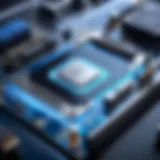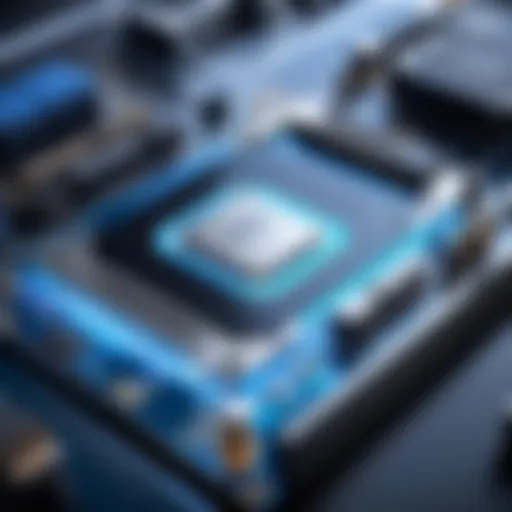Unlocking Laptop Power: The 64GB RAM Advantage


Intro
The integration of a 64GB RAM stick in laptops represents a significant advancement in computer technology. As the demands of software applications and multitasking continue to escalate, the need for enhanced memory capacity has become critical. This not only pertains to gamers who require swift graphics processing but also to professionals engaged in data analysis, machine learning, and other memory-intensive tasks. Thus, understanding the potential of such high-capacity RAM is essential.
In this article, we will explore various dimensions related to integrating a 64GB RAM stick into a laptop. We will delve into the product specifics, evaluating features, technology, performance comparisons, as well as the value proposition it offers. The intention is to provide a comprehensive understanding of how this substantial upgrade can transform the user experience across various scenarios and user types.
Preamble to RAM and Its Role in Laptops
The significance of Random Access Memory, or RAM, in the functioning of laptops cannot be overstated. As a crucial component, RAM acts as a temporary storage space where the operating system, software applications, and active data reside during operation. This section will examine the foundational elements of RAM, its evolution over time, and its overarching role in enhancing laptop performance. Understanding these aspects is essential for anyone considering an upgrade, such as integrating a 64GB RAM stick into a system.
Understanding RAM Basics
At its core, RAM is a type of volatile memory that is faster than traditional storage options like hard drives or solid-state drives. When a laptop runs a program, RAM enables swift read and write operations, significantly affecting the overall speed and responsiveness of the system. When users perform tasks that require immediate access to data, such as opening multiple applications or working with large files, ample RAM becomes critical.
For instance, while the processor executes tasks, it relies heavily on the information stored in RAM. If there is not enough RAM available, the system may resort to using slower disk space, resulting in delays and reduced performance. A 64GB RAM stick offers vast potential, particularly for users engaged in demanding tasks such as video editing, 3D rendering, or extensive data analysis.
Evolution of RAM Technology
The journey of RAM technology has seen remarkable advances. Early personal computers utilized relatively small amounts of RAM, often only a few megabytes. As software demands grew, RAM technology evolved from SIMM to DIMM modules, and later to DDR (Double Data Rate) memory, which enhanced performance and efficiency.
Today, we are witnessing a significant shift toward DDR4 and DDR5 RAM technologies. DDR4, for example, supports higher transfer rates than previous generations, while DDR5 aims to double the bandwidth, making it ideal for high-performance laptops.
This progression is not merely about size; it's also a matter of efficiency. As RAM evolution continues, the architecture is designed to reduce power consumption while maintaining high-speed data processing. Consequently, upgrading to a 64GB RAM stick can be seen as not only a scalability promise for future needs but also a step towards better energy efficiency in laptop operations.
"Investing in RAM is investing in the speed and performance of your laptop, reflecting the demands of modern computing."
Functions of RAM in Laptop Systems
The role of RAM in laptop systems extends far beyond mere data storage. It significantly impacts overall performance, system responsiveness, and the ability to execute numerous tasks simultaneously. As laptops evolve in complexity and capability, understanding the functions of RAM is crucial. In particular, integrating a 64GB RAM stick can enhance these functions to a level that aligns with today's demanding applications and user requirements.
Data Storage and Access Speed
RAM, or Random Access Memory, serves as the short-term memory of a laptop. Its primary function is to store data that the CPU needs in real-time. Unlike traditional storage types, such as SSDs and HDDs, RAM allows for much quicker data access. This speed can dramatically influence the performance of applications.
When a laptop has more RAM, it can hold a larger dataset in memory, which reduces the frequency of data retrieval from slower storage. For instance, loading high-resolution graphics for gaming or rendering large video files becomes much quicker with a 64GB RAM stick.
Additionally, performance improves in terms of system responsiveness. Users can experience seamless transitions between applications, as the data remains in RAM rather than requiring constant access to external storage devices. The latency between requests and responses shrinks, which enhances workflows in professional applications like video editing software or CAD programs.
An example of this principle is demonstrated in gaming scenarios where higher RAM capacity often translates to smoother gameplay. When a game is played, textures, character models, and game states are loaded into RAM for immediate use. The higher the RAM, the more of this data can be stored for quicker access on demanding levels.
"The superior speed of RAM can amplify application performance significantly and provide a competitive edge in resource-intensive tasks."
Impact on Multitasking
Multitasking is a common requirement for today’s users, whether for professionals juggling various projects or gamers who stream and play simultaneously. A 64GB RAM stick enables laptops to handle this multitasking demand effectively. It allows multiple applications to run concurrently without system slowdowns.
With more RAM, a laptop can keep more applications active in the background. This means resources are readily available, and switching between tasks becomes nearly instantaneous. For instance, a software developer may run an IDE, a local server, and a browser with multiple tabs open, all at once without facing the dreaded lag.
Moreover, creative tasks also benefit significantly. Video editors working with high-resolution 4K footage can maintain smooth playback and processing performance, reducing frustration during editing sessions.
In summary, the essential functions of RAM in laptop systems highlight its importance in overall performance and user experience. A 64GB RAM stick offers substantial advantages in data processing speed and multitasking capabilities, catering to a range of user needs from creative professionals to avid gamers.
Technical Specifications of a 64GB RAM Stick
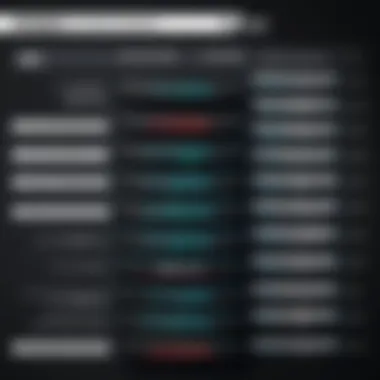

Understanding the technical specifications of a 64GB RAM stick is crucial for both enthusiasts and professionals who seek to enhance their laptop's performance. This section will delve into significant types of RAM, speed considerations, and the implications of latency. These aspects not only impact the operation of laptops but also help users in making informed decisions on upgrades.
Types of RAM Modules
DDR4
DDR4 RAM has become a popular choice for many laptop users due to its balanced performance and efficiency. One of the key characteristics of DDR4 is its ability to operate at lower voltage levels compared to its predecessor, DDR3. This reduction in voltage leads to better power consumption, which is critical for laptop users who depend on battery life.
The unique feature of DDR4 is its increased bandwidth capability, offering data rates that range typically from 2133 MT/s to over 3200 MT/s. This supports various heavy applications, ensuring that gamers and content creators can run multiple programs smoothly without compromising performance. However, one downside might be the limitation in upgradability when compared to DDR5, which will be discussed next.
DDR5
DDR5 RAM is the latest advancement in RAM technology, designed to meet the increasing demands of modern computing tasks. A key aspect of DDR5 is its enhanced speed capabilities, potentially reaching data rates of 4800 MT/s and beyond. This feature significantly benefits users who rely on intense processing tasks such as gaming, video editing, and software development.
A unique feature of DDR5 RAM is its increased capacity per module, allowing for larger memory configurations in a single stick. This is particularly advantageous for those looking at a 64GB RAM upgrade. However, DDR5 is still in the early adoption phase, meaning the availability might not be as widespread as DDR4, possibly leading to higher costs and compatibility concerns for some laptops.
Speed and Latency Considerations
Speed and latency are critical factors in understanding RAM performance. The speed of RAM, usually measured in megatransfers per second (MT/s), directly affects how fast data can be read from or written to the RAM. A higher speed translates into better responsiveness, particularly in data-intensive tasks.
Latency, on the other hand, refers to the delay before a transfer of data begins following an instruction. It is typically measured in nanoseconds and can significantly impact performance. In situations where quick access to data is essential, low latency RAM will outperform higher speed RAM with high latency.
Considering these elements helps users determine the most suitable RAM option for their specific usage scenarios, whether for gaming, creative applications, or regular tasks. By understanding both speed and latency, users can maximize the benefit they gain from upgrading to a 64GB RAM configuration.
Compatibility Considerations
When discussing a 64GB RAM stick, compatibility is essential. It encompasses both the motherboard’s ability to support such a sizable module and the operating system’s requirements. Without matching components, potential advantages of increased memory capacity may never materialize. Understanding these requirements can help users avoid unnecessary expenses and ensure a smooth upgrade experience.
Motherboard Compatibility
The motherboard primarily determines which types and sizes of RAM sticks can be used within a laptop. Not all motherboards can support a 64GB RAM stick, especially older models. Key factors to consider include:
- Memory Slots: Each motherboard has a limited number of DIMM slots. For instance, if a laptop has only two slots, it may require two 32GB sticks instead of one 64GB stick to reach the desired capacity.
- Supported RAM Types: Most modern laptops utilize DDR4 or DDR5 RAM. Ensure your motherboard explicitly supports these types. A user attempting to fit a DDR5 module into a DDR4-compatible motherboard may face issues.
- Maximum Capacity Limits: Each motherboard has a maximum RAM capacity it can handle. Check the manufacturer’s specifications before making any decisions. Installing excess RAM is a common mistake that can lead to wasted time and money.
"Compatibility is the bridge between potential and performance. Without it, higher specifications mean nothing."
In addition, the chipset plays a crucial role in compatibility. Specific chipsets feature support for higher memory speeds and capacities. Thus, as laptops age, their ability to accommodate advancements in RAM technology may diminish. Therefore, users must confirm compatibility to avoid frustration.
Operating System Requirements
Operating systems also play a significant role in how well a laptop utilizes RAM. Different operating systems have varying levels of memory support. Here are some key points:
- 32-bit vs. 64-bit: A 32-bit operating system can only handle up to 4GB of RAM. Transitioning to a 64-bit version unlocks the ability to utilize more RAM, including configurations like 64GB. Most modern systems, including Windows 10 and 11, macOS Catalina and later, and the latest Linux distributions, typically support 64-bit.
- Memory Management: Some operating systems handle memory more efficiently than others. Tools within the OS can optimize how applications utilize available RAM. This optimization becomes even more critical when working with high-capacity memory, ensuring applications run smoothly.
- Software Compatibility: Some applications are designed to take full advantage of larger RAM sizes. Graphic design tools, virtualization software, and high-end gaming platforms often benefit, while simple tasks like word processing may see negligible improvements.
As users contemplate upgrading to a 64GB RAM stick, understanding compatibility with both hardware and software is vital. This understanding not only facilitates smoother performance but justifies the investment by ensuring the RAM serves its full potential.
Performance Impacts of 64GB RAM
Integrating a 64GB RAM stick into a laptop can profoundly influence its performance across various applications. The increased capacity allows for more data to be processed simultaneously, which is especially relevant for users engaged in resource-intensive tasks. The performance increase can manifest in multiple ways, such as smoother gaming experiences, faster load times for applications, and improved capabilities for software development and creative projects.
Gaming Performance
Gaming has become a predominant use case for laptops with superior RAM capabilities. The demands placed on hardware during gameplay are significant. Gamers require quick and efficient data retrieval to enhance their in-game experiences. A 64GB RAM stick facilitates this need effectively.
Frame Rate Improvements
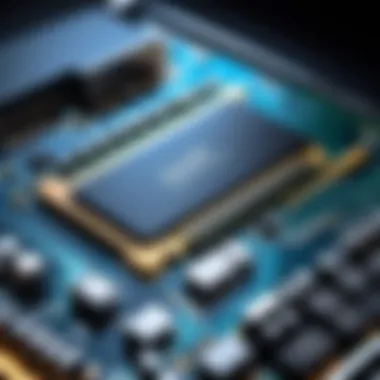

Frame rate is a critical aspect of gaming performance. Higher frame rates lead to smoother visuals, enhancing user experience. A 64GB RAM stick can contribute to frame rate improvements by ensuring the gaming environment is stable and quick to respond to player actions. This is particularly noticeable in games with expansive, detailed graphics that require substantial memory resources.
A unique feature of improved frame rates is the reduction of stuttering and lag during gameplay. This provides a competitive edge, especially in fast-paced online games where milliseconds can make a difference. However, it is essential to note that frame rate also depends on other hardware components like the graphics card, meaning that RAM is only one piece of the puzzle.
Load Time Reduction
Load time is another crucial aspect for gamers. Longer loading times can be frustrating and negatively impact engagement. With a 64GB RAM stick, load times can see a significant reduction. This characteristic is particularly beneficial in open-world games or those with extensive levels, as the RAM helps stream data more efficiently.
The unique advantage of reduced load times is instantly apparent when moving between game levels or entering new environments. Gamers appreciate this efficiency because it maintains immersion and reduces disruptions in gameplay. However, similar to frame rates, load time reduction can depend on storage solutions. Solid State Drives (SSDs), when combined with substantial RAM, yield optimal performance.
Software Development and Engineering Tasks
For software developers and engineers, the benefits of a 64GB RAM stick extend beyond just gaming. Development tools and environments often require substantial memory to run effectively. RAM plays a vital role in handling multiple tasks, from coding to debugging.
With 64GB of RAM, developers can run multiple virtual machines, compile code, and execute resource-heavy applications simultaneously without significant slowdowns. This capacity creates an efficient workflow, reducing the time spent waiting for tasks to complete. As coding frameworks and tools become more complex, the demand for increased RAM is likely to grow.
Creative Applications: Graphic Design and Video Editing
In fields like graphic design and video editing, memory demands are equally high. Creative applications such as Adobe Photoshop, Illustrator, and Premiere Pro require ample memory to handle large files and complex projects.
A 64GB RAM stick allows professionals to work with high-resolution images and video files smoothly. The large memory capacity ensures that these applications remain responsive, even when working on intricate designs or multi-layered edits.
The unique feature here is the ability to multitask effectively. A designer can have multiple applications open, switch between them without lag, and apply effects and edits seamlessly. However, users must also consider whether their laptops have the GPU and CPU performance to match the enhanced RAM capacity; otherwise, bottlenecks may still occur in the workflow.
"Upgrading to 64GB of RAM is less about immediate necessity and more about future-proofing for demanding creative projects."
Optimizing a laptop with 64GB of RAM can yield significant performance gains across gaming, software development, and creative tasks. As technology advances, adapting to higher memory needs becomes crucial for users wanting to maintain efficiency and fare well in demanding environments.
Cost Analysis of High-Capacity RAM
When considering integrating a 64GB RAM stick into laptops, conducting a thorough cost analysis becomes essential. This section reviews both financial implications and potential benefits of high-capacity RAM. Given the demands of modern software and applications, understanding cost-effectiveness is crucial for gamers, IT professionals, and tech enthusiasts.
Value for Money Considerations
Investing in a 64GB RAM stick queries whether the financial outlay aligns with the usage demands and expected performance gains. In the context of value, it is important to evaluate:
- Performance Gains: A higher RAM capacity typically translates to faster data processing. Applications, especially those demanding heavy memory, can run optimally with sufficient RAM.
- Longevity: As software development continues to advance, systems require more memory. A 64GB RAM stick may extend the usable life of the laptop, making it a worthwhile investment over time.
- Scalability: Options for future upgrades can impact decision-making. Investing in more RAM now can save costs if future software updates necessitate higher specifications.
Calculating the cost per gigabyte can assist in determining whether a 64GB RAM stick is a rational investment when compared to lower capacity alternatives.
Budget versus Performance
When evaluating a budget for high-capacity RAM, striking a balance between expenditure and performance is key. Factors to consider include:
- Initial Cost: A 64GB RAM stick comes at a premium. The upfront cost can be substantial, which may compel some to consider lower alternatives, such as 32GB.
- Long-Term Savings: While lower-capacity options may seem appealing initially, the total cost of ownership can shift the focus to high-capacity RAM. It avoids performance bottlenecks, reducing the risk of needing frequent upgrades
- User Scenarios: Understanding the specific needs based on usage scenarios can clarify whether it is prudent to choose higher capacity. For gaming or professional applications, the performance boost justifies the investment.
In summary, understanding the cost-analysis of high-capacity RAM requires careful consideration of user needs, performance expectations, and long-term savings versus immediate costs.
"A well-planned investment in RAM can lead to significant enhancements in system performance, especially for intensive applications."
Future Trends in RAM Technology
The landscape of RAM technology is changing rapidly. Understanding these future trends is crucial for anyone considering an upgrade to a 64GB RAM stick in laptops. Innovations in RAM technology not only enhance performance but also reshape how users engage with their devices. As applications demand more from hardware, staying updated with these trends can help users make informed decisions about their laptop setups.
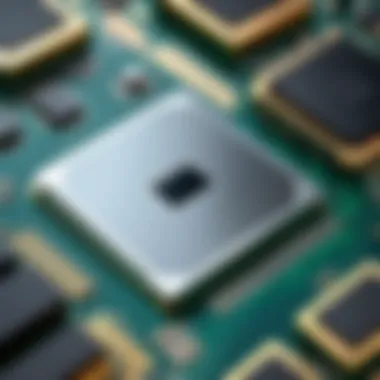

The Shift to DDR5 and Beyond
DDR5 RAM represents a significant advancement over its predecessor, DDR4. The primary benefits include higher bandwidth, lower power consumption, and improved data transfer rates. For users of demanding applications like gaming or video editing, these advantages can lead to smoother experiences with faster load times. DDR5 offers speeds that surpass 4,800 MT/s, which is a notable improvement, allowing for better multitasking and efficient data processing.
Considering that laptops increasingly require faster data access speeds for seamless operations, DDR5 provides a viable solution. It is also designed with future technologies in mind, ensuring that as software demands grow, memory technology can keep pace. The potential shift towards DDR6 and future iterations will likely bring even more enhancements, positioning users for scenarios that are not yet on the market.
Increasing Demands in Computing Power
As software becomes more sophisticated, its requirements in computing power increase correspondingly. This trend drives the need for higher-capacity RAM, especially in usage scenarios involving heavy multitasking, high-end gaming, or resource-intensive applications like data analysis and artificial intelligence. A laptop equipped with 64GB of RAM will likely cater to these emerging needs.
Here are some key factors contributing to the increasing demand:
- High-Performance Applications: New software versions often require significantly more RAM than their predecessors.
- Gaming Sector Growth: Modern games are becoming more complex and visually demanding, necessitating larger memory capacities to run smoothly.
- Remote Work and Collaboration Tools: As more people engage in virtual teamwork, the need for high-memory devices rises to support simultaneous tasks and applications.
In summary, keeping an eye on these trends in RAM technology is essential for optimizing laptop performance. Understanding tools like DDR5 and recognizing the escalated demands placed on computing power will inform decisions for upgrading to 64GB RAM, ensuring that users invest wisely in their tech capabilities.
Decision-Making Framework for Upgrading to 64GB RAM
The decision to upgrade to a 64GB RAM stick is significant. It influences overall laptop performance and affects user experience. Understanding the frameworks behind this choice is vital for those serious about their computing tasks. When evaluating such an investment, it is crucial to align this decision with personal or professional needs. This section lays out a structured approach to aid users in making informed decisions based on their specific contexts.
Assessing User Needs
Understanding user needs is the first step. Different users have varied requirements. For example, a gamer may need high-speed data access for seamless gameplay. Conversely, a software developer might prioritize multitasking capabilities to run multiple applications simultaneously. Here are key factors to consider when assessing user needs:
- Type of Work: Identify the primary tasks handled on the laptop. Are they gaming, video editing, or software development?
- Current Performance Issues: Analyze whether current RAM capacity causes slowdowns or glitches during typical usage.
- Future Needs: Consider future software requirements or upcoming projects that may require more memory.
- Usage Patterns: Observe how often heavy applications are used. This helps in determining if the RAM upgrade will yield noticeable improvements.
Collecting this information allows users to frame their decision accurately. If tasks involve heavy-duty programs or complex processing, opting for 64GB RAM becomes more justified.
Cost-Benefit Analysis for Different User Profiles
Conducting a cost-benefit analysis enables users to weigh the financial implications against the performance gains. This evaluation should be tailored to various user profiles:
- Gamers:
- IT Professionals and Developers:
- Creative Professionals:
- Cost: Higher-end RAM sticks are generally expensive, but they can be justified by the performance enhancements in modern gaming.
- Benefit: The improved frame rates and reduced load times can enhance overall gaming experience significantly.
- Cost: Investment in high-capacity RAM can strain budgets. However, consider amortizing this over the extended usage period.
- Benefit: Running Virtual Machines or intensive coding applications becomes smoother, leading to increased productivity.
- Cost: Creative applications often demand higher specification hardware. Budgeting for more RAM may divest funds from other peripherals.
- Benefit: Enhanced performance in graphic design or video rendering can vastly improve workflow efficiency.
Making an informed decision requires looking beyond the initial cost. A holistic understanding of potential performance gains according to user profiles is essential. This approach enables users to align their budgetary constraints with their computing requirements, leading to a more informed and satisfying purchase.
"Decisions about RAM upgrades should focus on specific needs and scenarios, rather than general trends."
In summary, by clearly assessing user needs and conducting a detailed cost-benefit analysis, individuals and professionals can approach the decision to upgrade to 64GB RAM logically. This framework ensures an investment that aligns with their long-term objectives and enhances their productivity.
Closure and Recommendations
The exploration of integrating a 64GB RAM stick into laptops demonstrates its substantial role in enhancing system performance. Upgrading to such high-capacity RAM can lead to notable improvements in multitasking capabilities, data processing speeds, and overall efficiency. This conclusion section synthesizes the key insights from previous sections, making it essential for users to recognize both benefits and considerations before committing to an upgrade.
Summarizing Key Points
In summary, the decision to upgrade to a 64GB RAM stick should reflect individual needs and usage scenarios. Here are crucial points discussed:
- Performance Benefits: A 64GB RAM stick significantly improves multitasking and allows smoother operation of demanding applications, such as gaming and video editing.
- Cost Considerations: Investing in high-capacity RAM can be substantial. A cost-benefit analysis is essential to gauge whether the performance gain meets one’s budget or not.
- Compatibility Factors: Compatibility with the laptop's motherboard and operating system must be confirmed. High-capacity RAM options might not be supported by all systems.
- Future-Proofing: As software continues to develop, the demands on RAM are likely to increase. Upgrading can help ensure that a laptop remains competent for future needs.
Future Considerations for Tech Enthusiasts
For tech enthusiasts, maintaining an awareness of future trends in RAM technology is vital. As we look ahead, several factors may shape the landscape of laptop memory:
- Advancement to DDR5: This next generation of RAM offers higher speeds and better efficiency, which could further enhance laptop performance.
- Increased Demand for Performance: With applications becoming increasingly resource-intensive, there may be a shift towards even larger RAM options in the coming years.
- User Customization Practices: As enthusiasts explore different configurations, the dialogue around optimizing setups for particular tasks will grow.


